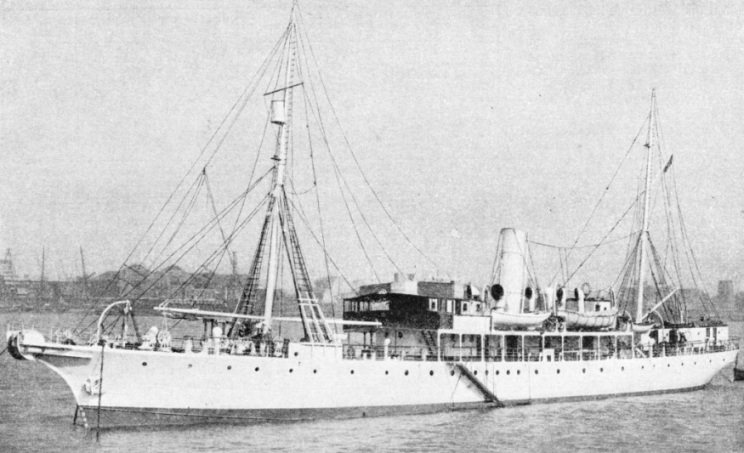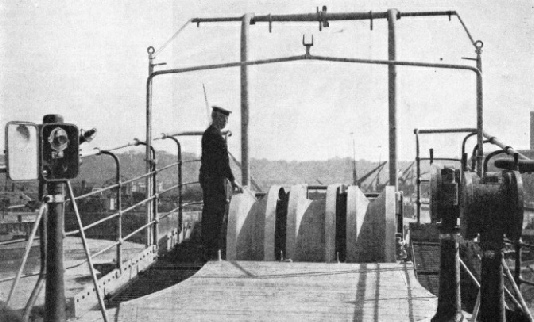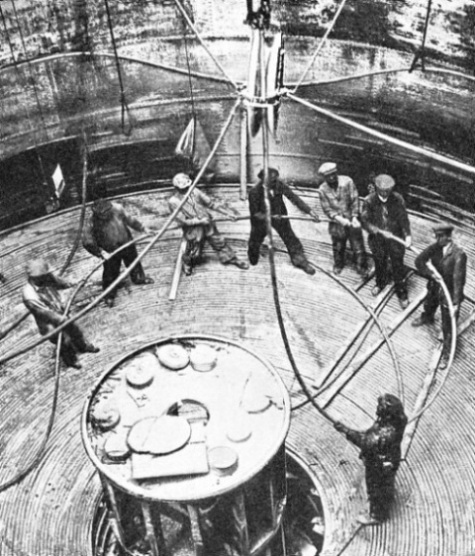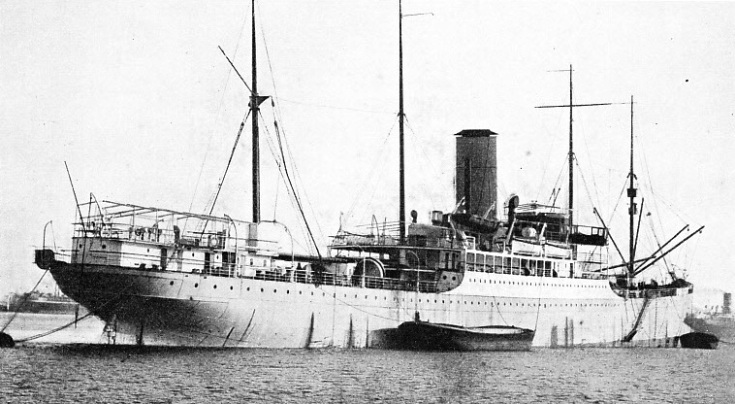

© Shipping Wonders of the World 2012-

Cable Ships at Work
The history of cable ships begins with the laying of the first successful cable between England and France in the middle of the last century. Despite tremendous opposition and heavy misfortune, the laying of the Atlantic cable began a new era in world communications

A POST OFFICE CABLE SHIP, the Monarch, successor to the famous Monarch of 1883, is a twin-
THE first commercially successful submarine telegraph cable to be laid was that between England and France. The cable left the English coast close to the South Foreland (Kent) lighthouse and reached France near Cape Sangatte, south of Calais. This cable was laid in 1850-
These successes astounded the sceptics, for, in common with most other innovations, the submarine telegraph was widely regarded as a foolish dream, and engineers and promoters were frequently hailed as charlatans and hood-
Many had been fired with the magnificent idea of joining Europe with America by telegraph, and numbers of projects had been suggested, but that stubborn, reactionary sentiment which found expression in accusations of dishonesty or in cheap sneers at the pioneers held things up for several years.
Eventually three men, Mr. Brett (who had put a cable across the English Channel), Sir Charles Bright and Cyrus Field, a retired American merchant, banded themselves together and floated the first Atlantic Telegraph Company. After financial difficulties and vicissitudes of one sort or another, work was started, and in 1857 HMS Agamemnon and the U.S. frigate Niagara began to lay the great cable, going westward from Ballycarberry Strand, Ireland, towards Newfoundland.
In those days it was almost impossible to pick up a cable once it had been laid, and therefore every effort was concentrated on preventing the cable from breaking as it was being paid out over the stern of the Niagara. But paying-
To-
However, the indomitable spirit of the sponsors of the Atlantic cable beat down all difficulties. More money was raised, and in 1858 another attempt was made. By this time paying-
Even this failure did not crush the spirits of the sponsors of the cable. Their optimism was infectious and gradually they instilled courage into their financial backers once more. Thus on July 17, 1868, the ships, which had come to be known as the “Wire Squadron”, made another attempt. This time they were successful. England was joined by cable with America and, after Queen Victoria and the President of the United States had exchanged messages of congratulation, news and commercial information began to flash between the two countries, opening up a new era in international communications.
Now comes one of the saddest chapters in the whole history of these early enterprises. The cable was gradually destroyed by electricity. The chief electrician, Mr. Whitehouse, was of the opinion that currents of a high potential were necessary for signalling, and because of this belief the cable had been worked at a potential of 2,000 volts. This slowly destroyed the insulation, and as the messages became weaker and weaker the strength of the current was increased.
The Second Atlantic Cable
The increase of current only hastened the end, and on October 20, 1878, the cable, laid after the overcoming of such vast difficulties and problems, became silent for ever.
It is now known that this cable might easily have been working to-
It is at this point that one of the most famous ships in the world comes into the history of the Atlantic cable. This ship is the Great Eastern, already described in the chapter beginning on page 841. However great a failure this ship was in other walks of life, she was a great success as a cable-
Two-
She had, however, proved herself an ideal vessel for cable-
The whole of the cable between Ireland and Newfoundland was completed, and as soon as the ends had been connected with the existing lines, London and New York were once more in telegraphic communication. The Great Eastern later laid cables from England to France and to Scandinavia, and in 1870 she laid the famous Suez-

THE SHEAVES AND PAYING-
The first ship to be permanently fitted out for the purpose of cable-
When the Post Office took over the cables of the United Kingdom in 1870 the Monarch was transferred from her owners, the Electric Company, but did not do much work as she broke down shortly after the change. In 1883 a new Monarch was built, and she was in her time one of the finest cable ships, or telegraph ships, as the Post Office prefers to call them. She was destroyed
during the war of 1914-
There is, however, still a Monarch in the service of the Post Office. She is a twin-
The first of all ships to be laid down on the slips especially for cable work was the Hooper, which was built on the Tyne in 1870 for Hooper’s Telegraph Works, Ltd. When she entered the Port of London in 1872 she was the largest steamer which had ever been in the Thames with the exception of the Great Eastern. The Hooper had a total carrying capacity of 8,000 tons, being able to store about 2,500 nautical miles of cable, and she could remain at sea for four months without refuelling.
In 1873 followed another remarkable cable ship, the Faraday, designed by Sir William Siemens. She was a double-
The honour of laying one of the longest cables in the world, the first great cable between Vancouver and Fanning Island (one of the Line Islands in the Pacific), fell to the Colonia, belonging to the Telegraph Construction and Maintenance Company. This ship, built in 1902, was of 8,017 tons. She laid many cables during her career, and in 1914-
The world’s largest cable ship, before her sale in 1936, was the Dominia. She was built in 1926, and is of 9,273 tons gross, with an overall length of 509 feet. She has twin screws and burns oil. She had four cable tanks. She was built for the purpose of duplicating the Vancouver-
Considering the loads they carry, cable ships have at all times been singularly free from trouble, apart from the incidents of war and isolated tragedies such as the sinking of the cable ship La Plata. Laden with cable for South America, she foundered off Ushant in a severe gale in November 1874. She went down stern first with a loud explosion, and only one boat, with fifteen survivors, succeeded in getting away.
It fell to the lot of a cable ship to be lost during that terrible catastrophe of 1902, the eruption of Mont Pelee in the Leeward Islands. Eighteen ships were sunk off Martinique, among them the cable ship Grappler, which had been busily engaged in restoring telegraphic communication after the first eruption. The Grappler was the first vessel to catch fire during this disaster and she was soon seen to turn over and disappear. Ships engaged on cable work are regarded more or less as “out of control”. To warn ships away from the cable-

A CABLE STORAGE TANK in a cable ship. These tanks are circular chambers in which the cable is carefully coiled. The tanks are kept flooded to prevent the gutta-
On occasion damage is done to submarine cables by submarine earthquake or volcanic eruption. The damage which a movement of the earth’s crust can do to a cable is enormous, for not only will the cable be severed but also many miles of it may be buried under tons of primeval ooze and cannot be reached by grapnels.
The science of seismometry has done good service to cable-
be due to a great earthquake which had occurred in the depths of the Indian Ocean.
In 1891 the Lisbon-
Serious Underwater Upheaval
One of the most serious submarine earthquakes known was that which took place as recently as 1921 in the North Atlantic at a point near the American coast where many transatlantic cables converge. The interruption in traffic was serious, and the cable companies called up every available cable ship to go out and make good the damage.
The Dominia, the Faraday and four or five other vessels left England and gathered in a radius of about 300 square miles. They found the work exceedingly arduous. Gales and hurricanes, with mountainous seas, were experienced, and for days it was impossible to let down grapnels, the ships being hardly able to keep their mark buoys in sight. The Dominia, for instance, put down a mark buoy in 2,840 fathoms and grappled for thirty-
Many miles of cable had to be abandoned, having been buried under tons of ooze, and the cables found were difficult to bring to the surface because of the depth to which they had been buried by the terrific upheaval of the sea-
During the war of 1914-
The cable ships during the war suffered little considering the danger to which they were exposed. With the exception of the loss of the Post Office’s ship Monarch and the torpedoing of the Dacia by a German submarine off Funchal, Madeira, scarcely any damage was done. The Telconia had a narrow escape in the English Channel. A German submarine sank a merchant vessel close to her and was manoeuvring into position to send a torpedo into the Telconia when, in answer to an SOS, two destroyers and a light cruiser arrived on the scene.
The Telconia also had a narrow escape from a mine. This was seen right ahead while she was at work. Instead of cutting the cable, the captain managed to steer out of the way of the mine, which passed about two feet from the Telconia’s side.

THE WORLD’S LARGEST CABLE SHIP was the Dominia, a twin-
You can read more on “The Famous Great Eastern”, “The Faraday” and ”Laying the Ocean Cables” on this website.
You can read more about The First Atlantic Cable in Wonders of World Engineering